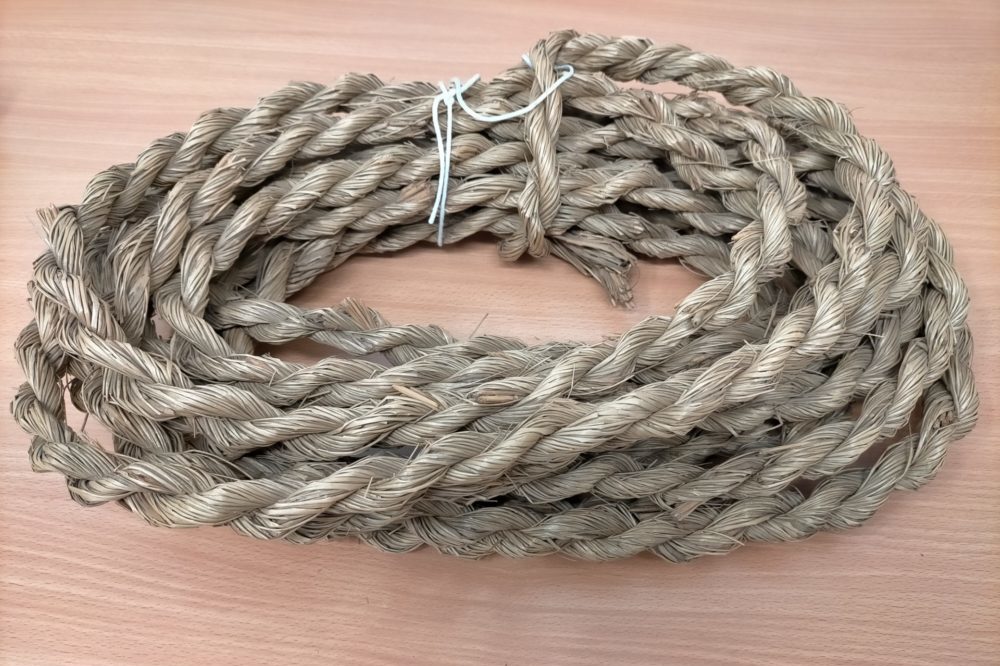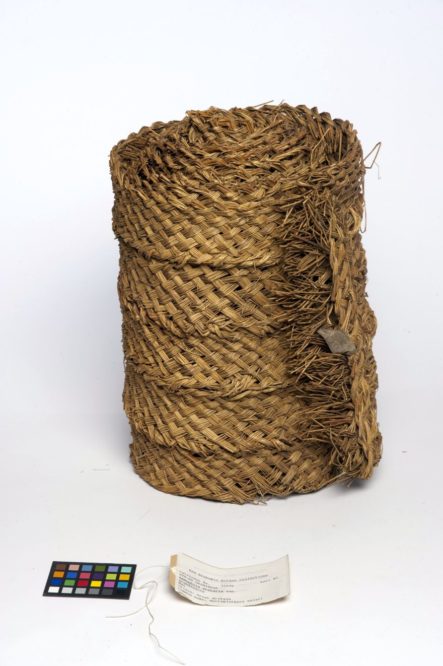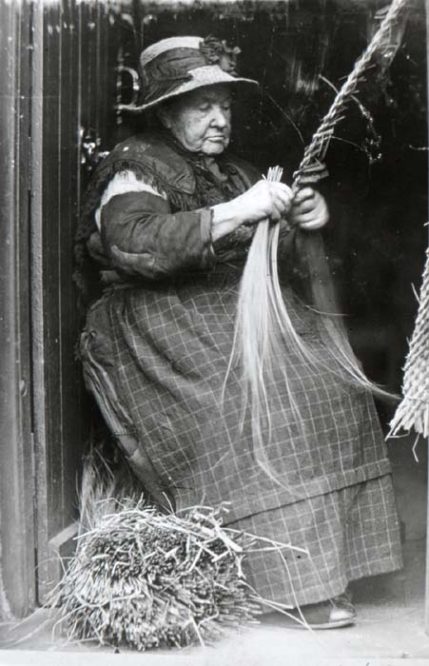Marram; Moresg part three: Marram heritage – the National Library of Wales

Julie Brominicks
Reflecting on my visit to Niwbwrch where I heard from Melissa about weaving, and remembering what Freya told me about marram having been used to make bee skeps, my next visit is to the National Library of Wales for a spot of research.
I find an online reference to both woven marram skeps and pack-saddle pads at the Scottish Highland Folk Museum. I also discover that on (Uibhist a Tuath) North Uist in the Outer Hebrides, Neil Nicholson still uses marram to thatch cottage roofs.
Closer to home, Heather Pardoe from Amgueddfa (Museum) Cymru emails me a photograph of a coiled marram rope purchased by A H Hyde for the museum’s Economic Botany exhibits in the 1920s for a collection labelled ‘useful and useless grasses.’
Natural History Museum
Meanwhile although Mark Carine at the Natural History Museum in London cannot find anything in his own collection, he helpfully sends me a link to the Kew Economic Botany database which holds written records of paper pulp, shoes, a hassock and a broom made from marram, and photographic records of a marram basket and a marram mat.
The latter bears a label: ‘These mats, which are used in churches and houses, are made by the Welsh peasants.’

Elsewhere in my reading I note that Thomas Johnson, in his Mercurius Botanicus (1641) described the inhabitants of Niwbwrch as having ‘no other handicraft than the manufacture of ropes, mats etc, from this grass.’
Like at Cynffig (Kenfig) and Cydweli (Kidwelly), Niwbwrch (Newborough) is one of several settlements around the coast of Cymru swamped by sand in 13th and 14th century storms.
In the centuries that followed a great storm in 1330 that destabilized the Niwbwrch dunes, sand ambushed farmhouses, villages and the medieval court of Aberffraw.
In 1561, this eventually resulted in Niwbwrch residents (who made marram rope, mats and baskets for barter or sale at markets) being banned from harvesting marram near the town for fear of more encroachment. Nevertheless the industry survived.

From the 18th to 20th centuries, Niwbwrch marram was woven extensively into mats used on floors or as haystack-covers. It was also woven into baskets and hassocks and used to make brooms and rope.
But in the Second World War, tanks practising for the Normandy landings mashed up the dunes again and post-war, Niwbwrch Forest was planted to re-stabilize them. This forest has subsequently become problematic for dune ecology. (It also provides long Corsican pine needles which Melissa has experimented weaving with and refuge to red squirrels, but that’s another story.)
The forest has been so successful in preventing the encroachment of sand it has become a physical barrier that stops the dunes behaving as they should; fluidly forming and reforming.
Having learned from Freya’s experience in New Zealand about the tenacity of marram roots, I am curious. Does simply harvesting the pliable grass alone – as Melissa and the weaving group are doing now – damage the plants enough to warrant a gathering ban? Presumably it depends on the extent of the industry.
And what about our contemporary understanding that healthy dunes actually need to be mobile so as not to destroy conditions for dune-dwelling wildlife? Might some of our dunes benefit from a little marram harvesting?

On the People’s Collection Wales website, I find a wonderful photograph uploaded by Llangefni Library, of Elen Williams of Niwbwrch plaiting marram rope with a pile of rough-looking grass at her feet.
I study this and at the photographs of rope and mats held at Kew and in Amgueddfa Cymru Musuem. They look hairy and fibrous compared to the elegant stream-lined baskets made by Melissa’s weaving friends which are more akin to the fine baskets on display in a cabinet in Niwbwrch Village Hall.
Still, from the photographs, it does look as if it is mostly grass rather than root that was being used; although I cannot really tell. Maybe the weavers had changed their practise since Charles Pierpoint Johnson’s time in 1862.
Because when I order the aforementioned ‘The Useful Plants of Britain’ from the archives and leaf through the old pages, I find a reference that suggests much more of the marram plant was once used.
‘The strong underground stems, which render it so valuable as a protection against the action of wind and waves, are capable of being made into ropes, and the people near the coast often plait them into mats… but the danger of its destruction in most places renders such applications by no means desirable.’
If this is true, and that in long past times it was the rhizomes that were most extensively used thus contributing to the destruction of the dunes, I moot that NRW allow basket-makers to harvest marram-grass without fear of damaging the roots and that New Zealanders begin making ropes and mats and thatch out of marram rhizomes in order to do the opposite.
Dunes
Possibly the industry could also be encouraged in areas of Cymru like Niwbwrch, where dunes need re-de-stabilizing. Would mat-makers not be preferable to excavators?
The National Library of Wales is a good place to write as well as research. I like to sit at the front of the reading room where a large window overlooks Aberystwyth.
Out there, beyond the town, white waves are pounding the coast. And I know that not far to the north is Ynyslas where there are dunes. I figure I’ll pay them a visit – I want to find out about dune ecology – and why it’s so important that they’re mobile.
References / Acknowledgements
Thanks to Heather Pardoe (Amgueddfa Cymru Museam), Mark Carine (Natural History Museum) for advice and permissions. Also thanks to the ever wonderful National Library staff.
Anglesey Antiquarian Society Transactions, ‘The Marram Grass Industry of Newborough, Anglesey’, 1956
Howe, M.A, Knight, G.T, Clee, C, ‘The importance of coastal sand dunes for terrestrial invertebrates in Wales and the UK, with particular reference to aculeate Hymenoptera (bees, wasps & ants)’, Springer Science and Business Medium, 2009
Johnson, Charles Pierpoint, ‘The Useful Plants of Great Britain’, 1862
Natural Resources Wales, ‘Coastal Sand Dunes in Wales’
Natural Resources Wales, Fact File, Marram Grass (Ammophila arrenaria)
Kew Economic Botany Database, Ammophila arenaria, https://ecbot.science.kew.org/index.php
Support our Nation today
For the price of a cup of coffee a month you can help us create an independent, not-for-profit, national news service for the people of Wales, by the people of Wales.





Fascinating- I didn’t know marram is a nuisance New Zealand Aoteoroa- I have been studying one small dune over there. Baskets etc here v similar ones to flax ones there, and the eel nets.
I remember the Uni of Wolverhampton had the Dunes on Abermaw beach under observation for years. This particular set of dunes disappeared for a century or so but have been increasing in size for the last thirty years…nice place for lunch, the library…
Let me know when you’re there MM – it would be nice to say hello
You mentioned Aberffraw, another gastro-village, the Llys does a great Rarebit…The Mawddach has seen a lot of changes in my lifetime, Julie have you come across an old book The Evolution of a Coastline, Barrow to Aberystwyth by William Ashton C1920…very interesting one man’s interpretation if I can put it like that. The ‘library’ will have a copy no firsts on line…it would indeed…
The last chapter in River of Tears has a lot to say about the Mawddach too…
Thank you Mab Meirion – I am surprised to say that I haven’t come across that book. I am however currently reviewing Seascape by Matthew Yeomans for this website which I think you will like. It explores the evolution of the Welsh coast’s past and probable future. It will be published in March. Recommended reading!
Seascape on request with our library…